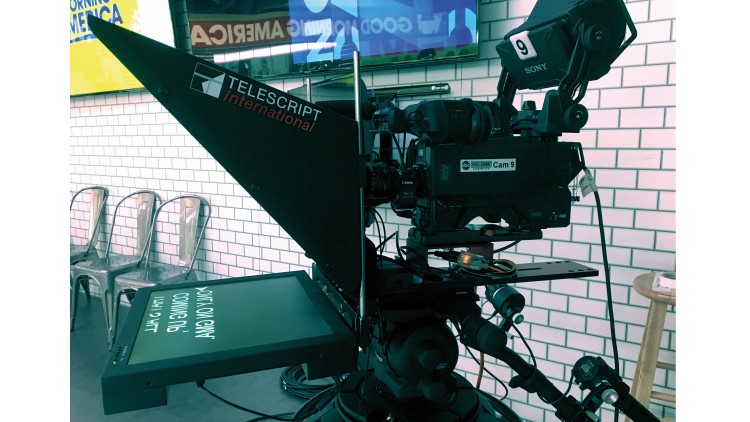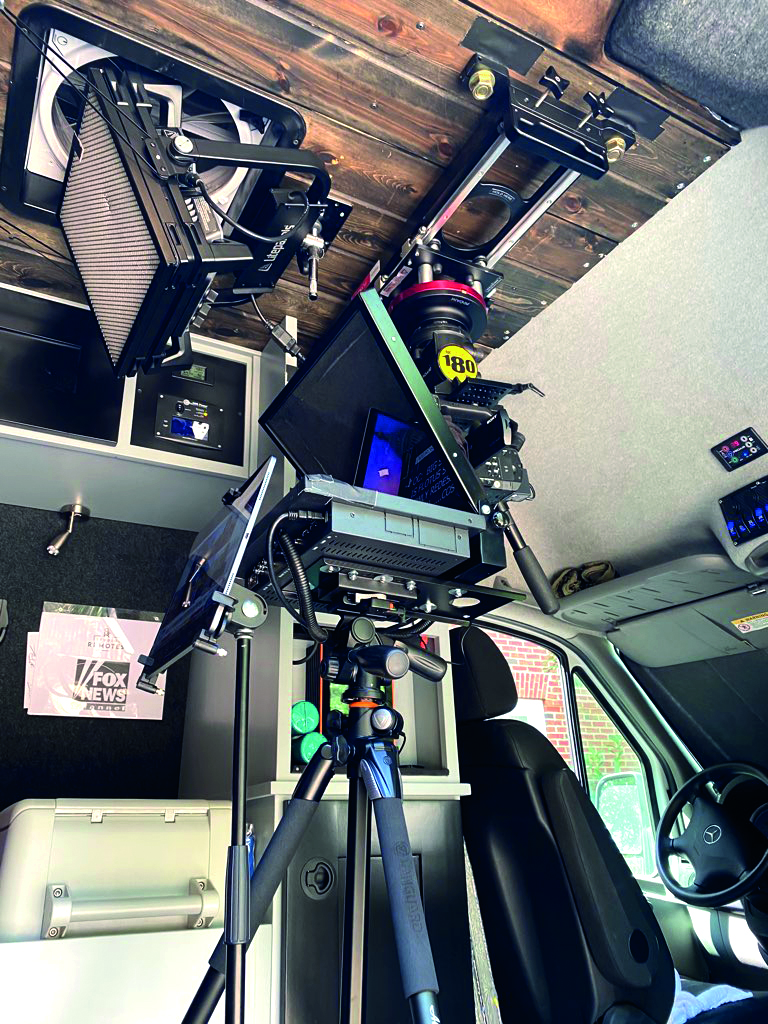The Art of ‘Iprompting’
Remote production, IP drive teleprompting innovations

LONDON—The teleprompter has long been a mainstay of live television, replacing the earlier and unkindly named “idiot board,” but still ensuring that on-air presenters get their lines right. Its necessary usefulness moved beyond TV into live events such as political conferences, corporate presentations and product launches.
Their ubiquity and effectiveness now extend into the realm of independent and individual internet broadcasters, to the extent that there are regularly videos on YouTube selecting the best teleprompters for YouTube.
SMALL AND PORTABLE
By its very nature, this end of the market is serviced primarily by systems in the $80–$1,400 price bracket but over the past year the higher-end manufacturers have been looking more closely at how their technology can be used both at and from home, for traditional broadcasters rather than YouTubers.
“We have seen an increase in the need to use smaller, more portable displays for prompter text, especially when home working,” said Robin Brown, product manager of Autoscript (part of the Vitec group with Autocue). “These screens are mostly tablet-sized and the ability to connect an iPad into the system as a prompter, without any added latency from streaming video, has been significant for many of our customers.”
Brown explains that “network coverage and simplicity of configuration” have made this way of working easily adoptable and simple to apply. The mass uptake of remote workflows was necessitated by the pandemic of the past year but has been enabled by the continuing evolution of connectivity technologies. “The speed of change in IP development and deployment—plus the global pandemic—has dramatically changed what users expect of prompting and what it can deliver,” said Brown. “Remote operations have become commonplace for users to request this mode of working, which is making for a buoyant market.”
Covid-19 has affected every person and every business, forcing media enterprises to find more ways to connect to small devices at remote locations, according to Chris O’Brien, president of Telescript International. The understanding and popularity of teleprompting has increased considerably, O’Brien says, with greater demand for these units not just in the home but new and established studios as well.
“The need for ‘smarter’ IP-based solutions is extremely important, which is why Telescript is partnering with a global technology company to add their IP into our monitors,” he said, adding that the details of this partnership will be announced this month.
Get the TV Tech Newsletter
The professional video industry's #1 source for news, trends and product and tech information. Sign up below.
FEWER PHYSICAL BOUNDARIES
A practical downside to the shift towards more compact devices is emerging technology meeting the limitations of human faculties.
“Everyone wants smaller but the problem is that the talents’ eyes are not getting any better,” said Michael Accardi, president of CueScript. “Small consumer-based products fall short on readability, connectivity and dependability. Now more than ever, people are depending on prompters to get the message out the first time and we have been designing systems that meet the customers’ needs. There is no room for error.”
In general, Accardi observes, the prompting market is scrambling to cope with the new normal. The reaction to Covid-19—with more home and remote working—has brought about new styles of broadcast operations, which extend to teleprompters.
“Today, operators and talent can be anywhere—they do not have to be together,” he says. “All physical boundaries have been lifted and it is common for an operator in their home to be prompting for multiple talent in multiple locations.”

Prompter vendors have been seeing very specific requests from end-users to meet these changing requirements, according to JT Meidl, president of Mirror Image Teleprompters, noting that one particular customer requested an iPad be mounted on the front of the company’s new LC-12 E camera teleprompter.
“The iPad acts as a talent monitor and receives a live network feed, allowing for perfect eye contact,” Meidl said. “The system was installed in the customer’s mobile studio van and has been used since the start of the pandemic by a major network.”
Studio equipment developers have also been looking at how to incorporate prompters into more compact and integrated systems. Robotic camera control specialist Telemetrics developed the Telepod with this in mind.
According to company Vice President Michael Cuomo, Telepod interfaces with “most teleprompting systems and automatically keeps the prompter facing the talent at all times and varying heights.”
Cuomo adds that the Telepod is a response to the trend for fewer personnel in TV studios. It includes the RoboEye 4K pan/tilt camera system, Televator Mini elevating pedestal, floor dolly and RCCP-2A robotic control panel featuring reFrame AI software. “Hands -free prompting will soon be used for all newscasts, going the way of the three camera setup of robotic camera that is now operated by one person in the control room,” he said.
INTEGRATION WITH THIRD PARTIES
Overall integration is the ongoing trend in broadcasting with Telescript’s Chris O’Brien adding that customers are increasingly looking for integrated IP prompting systems that work with the main newsroom technologies from the likes of ENPS, Avid iNews and Octopus while at the same time supporting SDI facilities.
“With many studios, colleges and TV professionals turning to IP solutions, teleprompting displays that natively connect to IP environments make adding prompting to a network easy,” he said. “The future is smarter, smaller, sleeker, with the emphasis on smarter systems that can interconnect through IP networks.”
Autoscript, a pioneer of IP workflows for telepromting, says its “Intelligent Prompting” system, which is fully-IP enabled, will similarly change how people use teleprompters.
“Our primary focus is building responsive technologies that enable broadcasters to work more flexibly and manage resources more efficiently,” Brown said. “Ensuring presenters always remain confidently on script is our goal because that’s the ultimate test of any prompting system.”
Accardi agrees that IP-based prompting “is not the future, it is today,” adding that the demand for flexibility, speed and dependability is driving development. He also does not see the new workflows developed for remote production will go away.
“This adoption of remote prompting will only expand, changing the way we do sports, location shoots, satellite studios and more,” he said. “Customers now understand how to leverage their existing systems and in turn we will see prompters in more places than ever before.”
